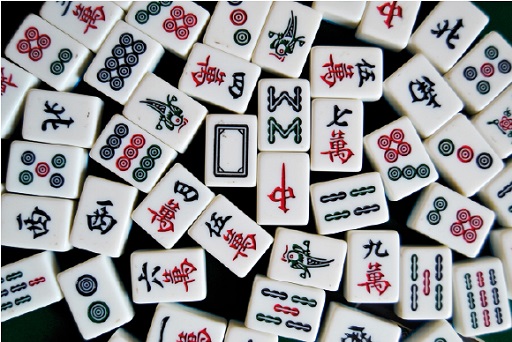3.1 Mahjong: the function of the clue–puzzle narrative
While much has been written about fairness, it is arguably a less important ingredient in crime fiction than the concept of ‘play’ itself. You have already learned about the importance of puzzles and riddles to the genre as a whole. Parlour games are often used as analogies in detective stories. Edgar Allan Poe, for example, makes reference to the marble game ‘even-and-odd’ in ‘The Purloined Letter’, and in the same story his detective Dupin uses the example of a map puzzle game to explain the success of his ‘hiding-in-plain-sight’ tactic. In Poe’s ‘The Murders in the Rue Morgue’ (1841), too, right at the outset, Dupin offers a lengthy disquisition comparing chess with draughts as a way of illustrating the ‘higher powers of the reflective intellect’ (which he counterintuitively believed were best characterised by the latter). These ludic analogies are not merely present to elucidate the method of the detective or the psychology of the villain, however. Games are symbolic, rather, of the genre’s consistent determination to reach out to the potential reader and to create a communitarian response that drives mass readership. In short, the reader is invited not just to read the text but to share in the deductive process of identifying clues and solving the puzzle of the crime.
The clue–puzzle narrative dominated the golden age. The plotting strategies of the form can be contrasted with those of the crime fiction thriller in that the present is largely pedestrian or ‘static’ and concerned with ‘unravelling past events’ just as the crossword solver unpicks the ingenuity of the setter, performed in the past. ‘Whodunnit’ is not merely a genre. It is, as you have seen, a sort of challenge issued by writer to reader (Priestman, 1988, pp. 1–2). The existence of ‘the rules’ underlines the importance of play, or the illusion of play, as quite possibly the most significant factor in the popularity of detective fiction. In this respect, Roger Ackroyd is – occasionally subtly, occasionally less so – a self-aware work. Several characters, including Poirot and Sheppard, make droll metafictional references to the genre of which they are a part: ‘I thought it was always done. It is in detective fiction anyway. The super-detective always has his rooms littered with rubies and pearls and emeralds from grateful Royal clients’ (Christie, 2012, p. 138). Christie is aware, above all, of the extent to which her genre involves – and is to some degree about – we the readers. Our self-awareness is something of a sub-plot in the novel itself and an active element within the author’s ruse.
Chapter 16 of the novel – ‘An Evening at Mah Jong’ – is arguably an allegory of this. It almost feels like an interlude in the narrative, although its timing later turns out to coincide with a crucial moment in Poirot’s deductive scheme. A Qing dynasty-era Chinese invention, mahjong is a tile game played by forming pairs and suits from a random array of tiles. Like the murder mystery, a (closed) circle of ‘players’ is required. British expats in China’s Shanghai Club play quickly, it is noted in the novel, and the English characters are ponderous, though they ‘perform’ their idea of the Chinese pace of play for a while (Christie, 2012, p. 196). Other than this, no real interest is expressed in the culture of origin of the game or in the travels of the Sheppards’ neighbour who professes an intimate knowledge of it. Above all, the players prize the notion of the ‘perfect winning’, which involves calling ‘mahjong’ with your original hand; a feat achieved by Sheppard to the amazement of the other players (Christie, 2012, p. 196).
Like Rummy, the winning strategy in mahjong is based on melding. Melding may only be achieved by drawing and discarding, which, as with Poe’s parlour games, might make this a symbolic representation of both the detective’s method and the novel’s structure. Though neither Sheppard nor Poirot (who is not present) make such a suggestion, the players discuss elements of the case while they play the game, so the allusion is inescapable. Knight argues that ‘Christie’s highly ornate plots make a testing, intricate puzzle and that in itself replicates bourgeois thinking’ (Knight, 1980, p. 117). We see this in the observations of the characters themselves. Many of them profess to be avid detective fiction readers and relish the element of competition it incorporates. One of the players at the table, Caroline Sheppard (the proto-Miss Marple), is the most obvious example of this, prizing success in various challenges available to her in the village setting: the mastery of gossip and secrets, the game of mahjong and the whodunnit puzzle itself. Success in all fields ‘is valued because it implies the unaided personal solving of life problems, dramatizes self-sufficiency and calibrates personal achievement’ (Knight, 1980, p. 117). Ironically, Miss Sheppard is the supreme example of failure in this regard, blind as she is to the true nature of her own brother. Poirot ultimately respects her character, even though she lacks the acumen Christie would later incorporate into the figure of Marple.

